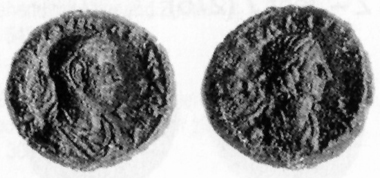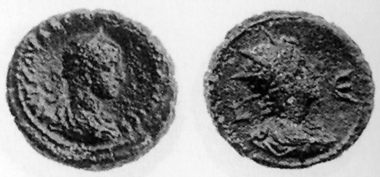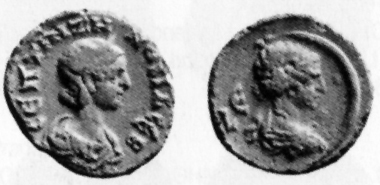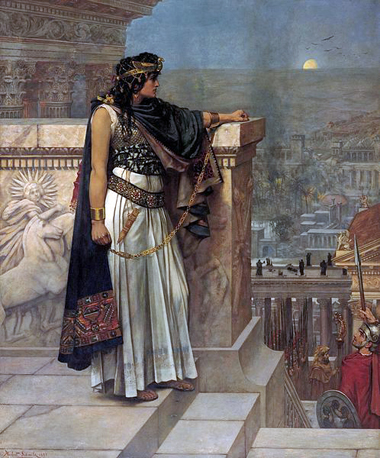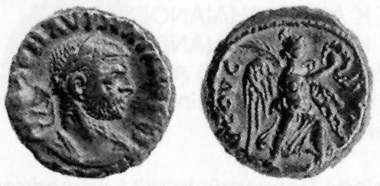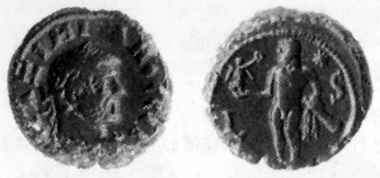The Queen of Palmyra
When the revolt of Mussius Aemilianus was crushed, the quarrels about Alexandria had by no means come to an end yet. It took only nine years for the next invasion force to arrive on the scene in order to get their hands on the important trading metropolis.
View at the capital of the empire of Palmyra. Photograph: diemert / http://creativecommons.org/licenses/by/1.0/deed.en
That had been preceded by a great gain in power for the city of Palmyra. Since the beginning of the 1st century A. D., that city belonged to the Roman Empire which, by the 3rd century, had more and more problems to protect Palmyra and the near-by Silk Road into the Far East. The citizens of Palmyra therefore became proactive. They proclaimed Septimius Odaenathus, one of their leading fellow citizens, exarch, i.e. head of the city. The Romans did nothing against that, on the contrary: around 250, Odaenathus was appointed senator, and in 257/8, Valerianus made him governor of the province of Syria Phoenice. Gallienus further cemented ties by proclaiming the client king ‘dux Romanorum’ (= commander of the Romans) and ‘corrector totius Orientis’ (= corrector of the whole east). In this capacity, in 262/3, Odaenathus managed to recapture the Roman province of Macedonia and to advance to Ctesiphon. The huge success was reason enough for him to declare himself autonomous and to take the title ‘king of kings’.
That lucky situation didn’t last long, though. When an invasion of the Goths summoned him to Asia Minor, he was assassinated in Heracleia Pontica in 267, together with his eldest son. His wife Zenobia was left a widow, and their under-age son Vaballathus immediately was proclaimed Odaenathus’ successor. Zenobia assumed power in his stead.
Hence, it was Zenobia who sent her troops to Egypt in 270, in order to take the country while the prefect chased pirates at the head of the Egyptian army by order of emperor Claudius Gothicus. Zenobia actually managed to capture the country at the Nile for a short period of time. But her troops were expelled as early as the summer: the prefect had aborted his campaign to retake his province again. In the same year, Zenobia sent another army, this time being much larger and much better equipped. The prefect was forced to flee, and Zenobia assumed control in Alexandria.
Aurelianus, 270-275, and Vaballathus. Tetradrachm, 270/1. Av. bust of Aurelianus with laurel wreath r. Rev. bust of Vaballathus with diadem and laurel wreath r. G. 3056. Blancon, list 31 (1999-2000), 746.
At first, she confined herself to exert this control in the name of emperor Aurelianus. Aurelianus, however, wanted none of an independent east. He moved his troops forward to Alexandria.
Vaballathus. Tetradrachm, 272. Rev. bust of Sol r. D. 5508. Blancon, list 31 (1999-2000), 756.
Zenobia made all the preparations to go to war and had coins issued in her own name…
Zenobia. Tetradrachmon, 272. Rev. bust of Selene in moon crescent. BMC 2398. Münzhandlung Basel 6 (1936), 1281.
…and the one of her son. At the beginning of 272, Aurelian defeated the army of Zenobia near Antiocheia. He advanced via Emesa to Palmyra, which surrendered after being besieged.
Zenobia looks at Palmyra one last time. Painting by Herbert Schmalz.
Zenobia was taken captive. While we know nothing about the fate of her son Vaballathus, the Historia Augusta (30.27) informs us that Zenobia spent her remaining years not far from Tivoli after having been made to walk in Aurelian’s triumphal parade.
Aurelian, 270-275. Tetradrachm, 274/5. Rev. Nike with wreath and palm branch going r. D. 5459. Blancon, list 31 (1999-2000), 741.
Thanks to his victory, Aurelian regained command over Egypt. Zenobia’s governor changed fronts and was engaged by the merciful new emperor.
Alexandria witnessed the next rebellion as early as spring 273. The driving force behind it most likely were the dissatisfied supporters of Palmyra who trooped up under Firmius of whom we are told many a fictitious anecdote but nothing of historical substance. Aurelian had to come to Egypt once again to quash the revolt.
Diocletian versus Domitius Domitianus
At the end of the 3rd century A. D., the Roman Empire in its then form proved to be ungovernable. Too many soldiers had to be fend off too many invasions, fewer and fewer tax payers had to bear the high expenditures for defense. It was due to old privileges and an ineffective administration that the means which flowed into the imperial treasure chest were far from being sufficient.
Diocletian, 284-305. Tetradrachm, 292/3. Rev. Nike, writing the emperor’s year in office onto a shield. G. 3266. Heidelberger Münzhandlung 20/I (1997), 580.
Diocletian decided to take action. Egypt was especially hard hit by his reforms. Although the coin reform of 293 hadn’t resulted in the abolition of the old Alexandrinian tetrachdrachms, the end of their issuing was scheduled for 297. A revision of the tax system was likewise planned for that year. First, all former tax privileges ceased to exist. Anyone became liable to capitation tax and had to pay dues on his products, whether they were made agriculturally or mechanically. And Diocletian insisted on punctual payment. That meant that the Egyptians not only had to pay the high current tax at once but also the great tax debts that had been accrued over years.
Maximian, 286-305. Tetradrachm, 290/1. Rev. Heracles with Nike and club. D. 5904-5907. Blancon, list 31 (1999-2000), 1028.
In addition, Alexandria suffered a significant loss of prestige. As from 30th August 297, the new division of Egypt, separated into Aegyptus, Thebaid and Libya, entered force. Alexandria lost its status as provincial capital – it could only maintain its ground as local center.
If that was the reason for Domitius Domitianus to rise up against the Roman central power is in dispute with scholars. Generally, pretty much everything related to the revolt of that usurper is in dispute. He may have proclaimed himself anti-emperor in the Thebaid in June/July 297 or in 296 already. He seems to have cooperated with the governor of Alexandria, Aurelius Achilleus. Be that as it may, Dioclectian – and that is academically ascertained – came to Egypt himself. He seemed to have defeated Domitius Domitianus at the end of 297, and Alexandria and Aurelius Achilleus as late as 298.
A perhaps well-made up anecdote about the punishment of the Alexandrinians, recorded by Malalas, is telling: Diocletian is said to have ordered to stop punishing the Alexandrinians only when the blood had reached his horse’s knee. But the Alexandrinians were lucky. The horse foundered and his knees got bloody when it touched the ground, which, according to tradition, prevented the emperor from any further cruel acts.
Egypt in late antiquity
In the second half of the 3rd century, Alexandria had lost much of its wealth. But it recovered again. The rich, fertile floods of the Nile made sure that Egypt maintained a breadbasket for the rulers in Constantinople. Alexandria, and above all its bishop, continued to occupy a special position.
Icon depicting Athanasius of Alexandria. Source: Wikipedia.
When today’s Christians all over the world pray the Catholic confession of faith, it harks back to the patriarch of Egypt, Athanasius, a somewhat unpleasant character who nevertheless shaped Christianity for centuries – just as much as western monastic life was derived from Egyptian ideals. Athanasius had a hand in that, too, who made the Egyptian hermit Antonius the perfect example of a monachos, of a person solely devoted to faith. Not least, we still meet an heir to the great maternal deity Isis, breastfeeding her child, when we look at the marvelous Gothic and Baroque depictions of Madonna lactans. It was primarily the Egypt of late antiquity that influenced our western civilization, but that is already beyond the scope of our timeframe, since, numismatically, Egypt didn’t take a special position in the Roman, and later the Byzantine Empire since the middle of 298.
You can find the other parts of this series here.






